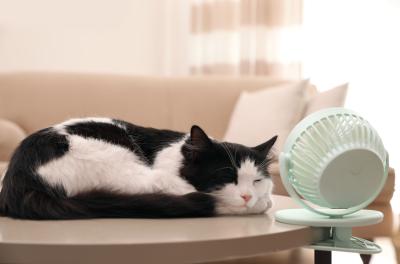
Has your cat’s hacking and coughing left you asking, “What are cat hairballs?” If so, read on for some answers to your most common cat hairball questions. Cat hairballs are not a mystery, and they are just what you might imagine: a collection of cat hair that your cat has swallowed, largely by licking her body during the natural act of grooming. In addition to dead hair, hairballs also contain digestive juices from your cat’s stomach.
It's no secret that most cat breeds have no affinity to water, so they are very good at keeping themselves groomed and clean. In fact, the cat’s tongue is equipped with little projectiles, known as barbs, which are an example of one of nature’s most ingenious designs. Each barb faces backwards on the cat’s tongue, so they are super-efficient at latching onto loose cat hairs to help your cat keep her coat looking its best. Thanks to these barbs and your cat’s persistent and instinct-driven process of cleaning herself, she rarely if ever needs a bath — or your assistance with bathing. Still, hairballs are a natural drawback to all that self-grooming, formed when cats swallow tiny loose hairs that evolve into a hairball over time.
Symptoms of Cat Hairballs
While it can be distressing to watch your cat produce a hairball, the longer you own a cat or cats in general, the more accustomed you will grow to the symptoms of cat hairballs when she is trying to bring one up from her stomach. Signs of cat hairballs may include your cat gagging, hacking or retching as she tries to vomit out the ball of hair. Some pet owners describe it as a “cough,” followed by a “gag” and then the act of the cat retching. The cough may appear to come from her lungs, the gag from her throat and the retch from the cat’s stomach.
Are Cat Hairballs Normal and Can They Be Dangerous?
Upon seeing their cats hack and cough to expel a hairball, most cat owners are left wondering if cat hairballs are normal. And yes, it is perfectly normal for your feline to get a hairball every now and then. Typically, hairball formation is nothing to worry about, and most cats get them from time to time. Your cat needs to self-groom to keep her coat in the best condition possible.
Usually, individual hairs that your cat removes with her barbed tongue are simply passed through her digestive system without causing hairballs to form. However, over time, single hairs can begin to form clumps that attract other single hairs, and they accumulate to form hairballs. Your cat is naturally inclined to try to expel a hairball to prevent it from going to her intestine, where it can result in a blockage. It’s not uncommon for a cat to stretch her neck, dry retch with her mouth opened alarmingly wide and then calmly leave the hairball laying there. Sure, it’s worrisome to watch, but it is not harmful.
You may be naturally inclined to help your cat when she seems distressed and struggles to bring up a hairball. The best help you can be to her, however, is to give her plenty of room and be watchful of her to make sure that she brings the hairball up and that the gagging ceases.
Hairballs are no cause for concern, generally. However, if a hairball moves to your cat’s intestines, it can result in a serious condition when the intestine becomes blocked. If your cat experiences any of these symptoms, seek out veterinary care immediately:
- Retching, gagging and vomiting without expelling a hairball
- Reduced or no appetite
- Lethargy
- Diarrhea or constipation
- Excessively eating grass
- Sensitive or swollen stomach
How Often Should Cats Get Hairballs?
Since most hair passes harmlessly through your cat’s digestive tract and finds its way into her litter box without issue, hairballs are never an everyday event. Your cat should only get a hairball from time to time — typically, once a month or less frequently. Still, it is not unheard of for cats to experience more frequent hairballs, which can be an indicator of a gastrointestinal tract issue. If you notice that your cat is hacking up hairballs more often than once each month, it is a good idea to have her evaluated by your veterinarian to rule out any problems with her digestive system.
In the absence of any stomach issues, your cat may be overgrooming if she is expelling frequent hairballs. Like humans who bite their fingernails when they are stressed, cats groom themselves too often when they are feeling stressed out. This can occur in cats of any age but is particularly true of older cats, who sometimes grow fussier with each passing birthday and, because of this, produce more hairballs. If you believe your cat may be stressed, talk to your veterinarian about it for ways to help your cat cope.
Do Certain Cats Produce More Frequent Hairballs?
Most cats produce hairballs at least occasionally, although cats produce fewer hairballs during kittenhood and their early years, largely because they are not as fastidious groomers. As you can imagine, a cat with lots of hair (we’re looking at you, Himalayan, Maine coon and Persian breeds) are also more naturally prone to the development of hairballs.
What Cat Food Helps With Hairballs?
Although there’s nothing you can do that will completely prevent hairballs from forming, you can help reduce hairballs by regularly brushing your cat to help her shed, which removes loose and dead hair from her coat, so there’s fewer hairs for her to ingest to begin with. If your cat doesn’t enjoy you grooming her or if you are uncomfortable doing it, schedule regular grooming appointments to have her trimmed, especially if your cat has long hair. In addition, think about feeding her a cat food formula made specially to reduce the occurrence of hairballs in cats by helping to increase your cat’s intake of fibre.
Related articles



